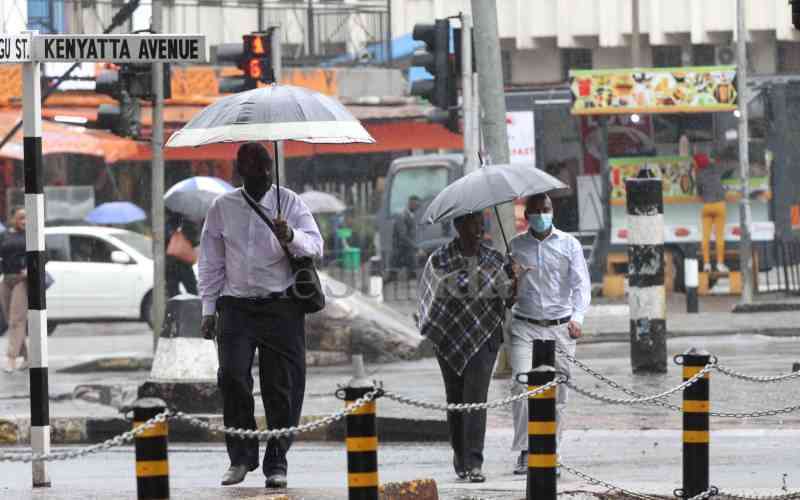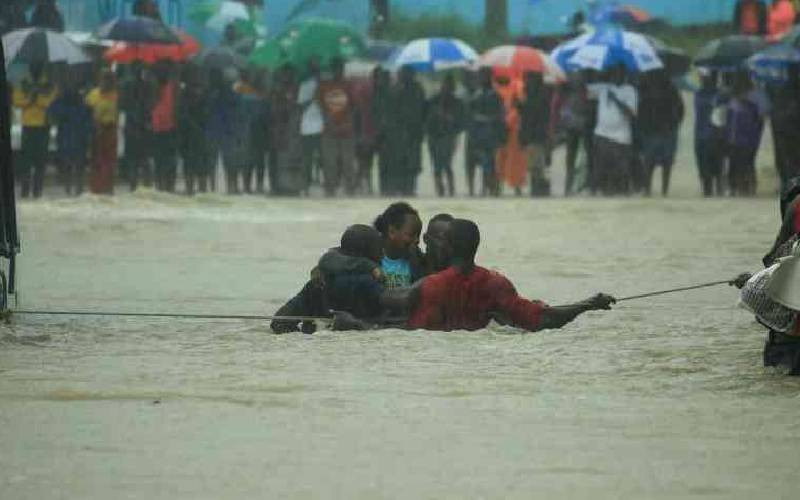 |
|
Dozens of sand quarries line the course of Lake Nakuru’s water catchment area and operators claim to have permits from the National Environmental Authority. [Photo: Joseph Kipsang/Standard] |
By Frankline Sunday
Kenya: Population growth, wanton destruction and encroachment on water catchment areas are the factors attributed to the flooding that has led to the abnormal rise of water in the Rift Valley lakes.
“Human activity and urbanisation has contributed to adverse degradation of the Rift Valley water catchment areas. It is regrettable that today, the landscape is dotted with towns and settlements where forests and swamp lands were situated previously,” says Edwin Kimeto, regional official of the Water Resources Management Authority (WARMA).
Data from the Kenya National Bureau of Statistics indicates that the population of the Rift Valley has doubled over the last 15 years, from 6 million in 1999 to over 10 million today.
“There is massive development in rural areas and we are having instances of heavy commercial farming in areas that have been gazetted as water catchment zones, with some farmers cultivating as close as two metres from the banks of the river,” he explains.
In addition to the illegal cultivation in water catchment areas, Baringo County is composed mostly of livestock herders and many families depend on goats and cattle as their chief economic activity.
“The population of livestock in the area has also increased and residents are grazing their animals on the river banks thus exposing the soil. This has lead to massive erosion of the soil which is washed out to the rivers and lakes, causing a heavy siltation,” explains Mr Kimeto. Charcoal burning has led to loss of forest vegetation.
Johanna Karato is the chairman of an association of farmers and pastoralists that has 600 members under its umbrella. We caught up with Mr Karato as he was preparing to chair a meeting of farmers and herders that was meant to plan for activities in the wake of the coming long rains.
“We have many families in the region that depend on farming and are even facilitated by the government,” he explains.
Karato however admits that the number of farmers has been increasing in the last 8 years since they began heavy commercial farming and some members are flouting environmental regulations.
“In the past, we had less than a dozen cases of farmers cultivating in the catchment areas and they only used small acreages of between a quarter and one acre,” he explains.
He says that the case is different these days. “More people have taken to farming and we are having as much as 100 people going into the swamps, with some cultivating up to 20 acres which is risky. We are telling our members and other farmers to move away from the catchment areas and behind the designated boundaries,” says Kimeto.
Karato is skeptical about the rise in water levels and whether or not he sees a connection to their economic activity. “From what we understand and the information passed down to us from our fathers is that the water is just reclaiming its territory because these were its original levels 100 years ago,” he says.
At the same time, environmentalists and conservation officials in the Rift Valley are finding it diffucult to explain to the residents the cause and effect relationships that contribute to silting, thus facilitate the flooding in the lakes. This has made Raphael Kimosop’s job frustrating.
Kimosop is an environmental researcher and planner in the Lake Bogoria catchment area. He has been working with the county reserves for the last seven years.
Stay informed. Subscribe to our newsletter
“We have cross-referenced the level of water now against historical images of the level in 1901 and the similarity in the pattern indicates that there is a high chance of the water reclaiming the land it had back then,” he explains.
Lake Nakuru
He says that the problem is that in the last 100 years, people have encroached on those areas.
The reluctance to give way to nature and cede what was originally hers is more pronounced in the Lake Nakuru ecosystem, 90 kilometers away.
Here, the growing cosmopolitan town of Nakuru is exerting its pressures on Lake Nakuru, the most visible of the Rift Valley lakes.
In the last three years, the lake has burst its banks and spread from an area of 31sq.kms in January 2010 to 54sq.kms in September; a 72 per cent increase in the level of lake water.
Because of this, Lake Nakuru National park, the largest revenue earner for Nakuru County has had much of its infrastructure submerged by lake water. Parts of the park are inaccessible.
We followed the course of the River Njoro, the largest river that drains into Lake Nakuru, just to see for ourselves the pollution that finally ends up into the lake. All along the course of the river, the water takes a progressively murky colour as it transects towns, slums and flows by industries on its way to the lake.
The river passes through Kaptembwa, a residential area that is populated by informal and semi-formal settlements whose residents have irregular access to piped water.
Since the cost of buying water from vendors is out of reach for many families in the area, many residents have turned to the river for their basic water needs. The result is several makeshift water points where women wash clothes with the soapy water and scum draining back into the lake. “We cannot come out and outright ban the use of the river water because many of the residents have no alternative source of water,” says Rashid Abdalla, the chief of Kapkures Location.
He notes that the problem is that most of the residents have no regard to proper use of this resource and inevitably pollutants like soapy water and other foreign elements find their way into the water. The course of the river and areas neighbouring the lake are dotted with quarries where hundreds of young men extract sand that is used in the region’s growing real-estate industry.
Property prices
The fourth largest town in the country, the population of Nakuru has quadrupled from 163, 927 residents in 1989 to 457, 495 projected by next year.
Property prices in the town have skyrocketed. The result of this growth has been a demand for cheap building material and this demand has fuelled the sand harvesting business around the town. Leonard Korir works in one of the quarries along the course of Njoro River. “Sand harvesting provides a source of livelihood for tens of thousands of young people in this region,” he said.
The same river flows through a solid waste disposal plant just before it drains into Lake Nakuru and from several viewpoints it is clearly visible that the river water is merging with raw sewage from the plant and draining this into the lake.
 The Standard Group Plc is a
multi-media organization with investments in media platforms spanning newspaper
print operations, television, radio broadcasting, digital and online services. The
Standard Group is recognized as a leading multi-media house in Kenya with a key
influence in matters of national and international interest.
The Standard Group Plc is a
multi-media organization with investments in media platforms spanning newspaper
print operations, television, radio broadcasting, digital and online services. The
Standard Group is recognized as a leading multi-media house in Kenya with a key
influence in matters of national and international interest.
 The Standard Group Plc is a
multi-media organization with investments in media platforms spanning newspaper
print operations, television, radio broadcasting, digital and online services. The
Standard Group is recognized as a leading multi-media house in Kenya with a key
influence in matters of national and international interest.
The Standard Group Plc is a
multi-media organization with investments in media platforms spanning newspaper
print operations, television, radio broadcasting, digital and online services. The
Standard Group is recognized as a leading multi-media house in Kenya with a key
influence in matters of national and international interest.









